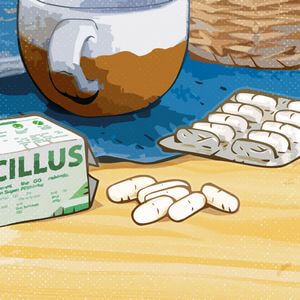Lactobacillus

A weight gain
Lactobacillus is a Gram-positive1 bacillus that can be seen in violet under the microscope, being stained by the gentian violet/lugol complex. There are many species of lactobacillus with different effects. For example, Lactobacillus fermentum is a bacterium that can induce weight gain, as demonstrated in infected chicks. Therefore, some lactobacilli are used in the food industry to fatten animals. Some lactobacillus are also used in the food industry, for example to produce cheese and other fermented milk products.
A beneficial bacillus
Lactobacillus is also found in certain medical preparations. For example, the probiotic2 drug “Infloran” contains Lactobacillus acidophilus and Bifidobacterium infantis. This kind of probiotic is used in premature babies to prevent a specific inflammation of the digestive tract called necrotizing enterocolitis3. Lactobacillus is a good example of probiotics2 and demonstrates that bacteria can be beneficial to health.

At the vaginal level, lactobacillus is the predominant bacterium. It helps to maintain acidic conditions, which lead to a reduced colonization of the vagina by pathogenic4 germs. The lactobacillus also produces antimicrobial molecules, particularly effective against enterococci5 and certain Enterobacteriaceae6.
- Black cards
- Akkermancia muciniphila
- Aspergillus fumigatus
- Bifidobacterium
- Candida albicans
- Chlamydia trachomatis
- Clostrioides difficile
- HBV
- HPV
- Human immunodeficiency virus
- Klebsiella pneumoniae
- Lactobacille
- Leishmania
- Leptospira interrogans
- Neisseria meningitidis
- Mumps virus
- Streptococcus pneumoniae
- Rickettsia prowazekii
- Measles virus
- Rubella
- Toxoplasma gondii
- Treponema palidum
- Chickenpox virus
- Vibrio cholera
- Zikavirus
